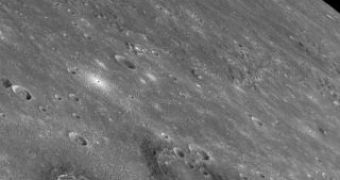Data collected during the fly-by around Mercury by NASA's MESSENGER orbiter is still pouring in, revealing new and surprising facts about probably the least studied planet in the solar system. Upon reviewing some of the photographs taken on January 14, NASA astrophysicists discovered a series of craters along the surface of Mercury surrounded by dark features, while the bottom region looks as a surprisingly bright patch of land.
MESSENGER science team member Clark Chapman says: "The halos are really exceptional. We've never seen anything like them on Mercury before and their formation is a mystery". Chapman is also part of the Southwest Research Institute in Boulder, Colorado.
For example, in the featured picture above, we can see the giant Caloris Basin, a depression measuring about a thousand kilometers in diameter, which appears to have formed during a massive collision between Mercury and a comet or, possibly, even an asteroid. The largest crater within this basin is 64 kilometers in diameter and both craters show evidence or dark rims surrounding a bright inner bottom.
According to Chapman, there are only two possible explanations for the appearance of these features. The Caloris Basin could contain layered dark material under its surface, which could have been exposed during impact. The problem is that this theory states at the same time that layered material should be found all over Mercury, not only in the Caloris Basin. Indeed, there is evidence that dark rims or halos are present elsewhere than in the Caloris Basin; at least two such craters presenting these features exist in the vicinity of Mercury's south pole.
Alternatively, Chapman proposes the creation of dark material due to extreme heat generated during impact. Molten rock and other rocky debris could have been thrown away from the impact zone to create glassy materials similar to those found on Earth or even on the Moon, although the halos on Mercury are much more distinct than those previously discovered.
Chapman argues that the difference could be made by gravity. The Moon's gravity is only 1/6th of that on Earth, meaning that the debris kicked out by a possible impact could fly far away. Mercury's gravitational pull, on the other hand, is double that of the Moon, thus the debris would not fly as far as that on the lunar surface and remain confined to an area in the close proximity of the impact site.
But what about the bright material observed in the bottom of the crater? Well, one thing is for certain: it can't be ice, as at the time when the photograph was taken the surface temperature of the planet in the respective region easily exceeded 400 degrees Celsius. The only possible explanation would be that it is brighter material also part of the layered pattern, which was exposed after the impact. Scientists can't state it for certain right now, since the data collected during the fly-by is still being processed.
And if no valid explanation shows up, there are still two remaining fly-bys until MESSENGER enters a permanent orbit around Mercury by 2011, enough time to study the features in detail.

 14 DAY TRIAL //
14 DAY TRIAL //